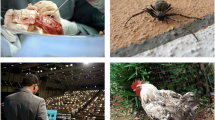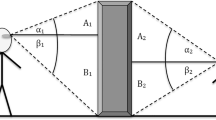Abstract
The purpose of this study was to test a novel pictorial emotional Stroop paradigm that required participants to name the colors of filtered images on a computer screen. High (n = 20) and low (n = 20) snake-fearful participants color-named filters covering images of snakes (threat), cows (neutral), bunnies (positive), and blank screens. Each image appeared as if viewed through tinted sunglasses. The results revealed that both groups took longer to name the colors of filters covering bunnies as well as snakes relative to filters covering cows. Intensely snake-fearful individuals (n = 5), however, exhibited additional interference for snake pictures beyond that evoked by bunny pictures. Thus, pictorial cues having positive as well as negative emotional valence disproportionately captured attention. This paradigm shows promise as a nonlexical, ecologically valid approach to evaluating selective processing of emotional cues.
Similar content being viewed by others
REFERENCES
Kindt, M., & Brosschot, J. F. (1997). Phobia-related cognitive bias for pictorial and linguistic stimuli. Journal of Abnormal Psychology, 106, 644–648.
Kindt, M., & Brosschot, J. F. (1999). Cognitive bias in spider-phobic children: Comparison of a pictorial and a linguistic spider Stroop. Journal of Psychopathology and Behavioral Assessment, 21, 207–220.
Klorman, R., Weerts, T. C., Hastings, J. E., Melamed, B. G., & Lang, P. J. (1974). Psychometric description of some specific fear questionnaires. Behavior Therapy, 5, 401–409.
Lang, P. J., Öhman, A., & Vaitl, D. (1988). The International Affective Picture System [Photographic Slides]. Gainesville, FL: The Center for Research in Psychophysiology, University of Florida.
Lavy, E., & van den Hout, M. (1993). Selective attention evidenced by pictorial and linguistic Stroop tasks. Behavior Therapy, 24, 645–657.
MacLeod, C. M. (1991). Half a century of research on the Stroop effect: An integrative review. Psychological Bulletin, 109, 163–203.
Mansell, W., Clark, D. M., Ehlers, A., & Chen, Y.-P. (1999). Social anxiety and attention away from emotional faces. Cognition and Emotion, 13, 673–690.
Martin, M., Williams, R. M., & Clark, D. M. (1991). Does anxiety lead to selective processing of threatrelated information? Behaviour Research and Therapy, 29, 147–160.
McNally, R. J. (1998). Information-processing abnormalities in anxiety disorders: Implications for cognitive neuroscience. Cognition and Emotion, 12, 479–495.
McNally, R. J., Kaspi, S. P., Riemann, B. C., & Zeitlin, S. B. (1990). Selective processing of threat cues in posttraumatic stress disorder. Journal of Abnormal Psychology, 99, 398–402.
Öhman, A. (1996). Preferential preattentive processing of threat in anxiety: Preparedness and attentional biases. In R.M. Rapee (Ed.), Current controversies in the anxiety disorders (pp. 253–290). New York: Guilford Press.
Riemann, B. C., & McNally, R. J. (1995). Cognitive processing of personally relevant information. Cognition and Emotion, 9, 325–340.
Rosenthal, R., & Rosnow, R. L. (1985). Contrast analysis. Cambridge, UK: Cambridge University Press.
Rosenthal, R., & Rosnow, R. L. (1991). Essentials of behavioral research: Methods and data analysis. New York: McGraw-Hill.
Rosenthal, R., Rosnow, R. L., & Rubin, D. B. (2000). Contrasts and effect sizes in behavioral research: A correlational approach. Cambridge, UK: Cambridge University Press.
Snider, B. S., Asmundson, G. J.G., & Wiese, K.C. (2000). Automatic and strategic processing of threat cues in patients with chronic pain: A modified Stroop evaluation. Clinical Journal of Pain, 16, 144–154.
Spielberger, C. D., Gorsuch, R. L., Lushene, R., Vagg, P. R., & Jacobs, G. A. (1983). Manual for the State-Trait Anxiety Inventory. Palo Alto, CA: Consulting Psychologists Press.
Thorpe, S. J., & Salkovskis, P.M. (1997). The effect of one-session treatment for spider phobia on attentional bias and beliefs. British Journal of Clinical Psychology, 36, 225–241.
Williams, J.M. G., Mathews, A., & MacLeod, C. (1996). The emotional Stroop task and psychopathology. Psychological Bulletin, 120, 3–24.
Author information
Authors and Affiliations
Rights and permissions
About this article
Cite this article
Constantine, R., McNally, R.J. & Hornig, C.D. Snake Fear and the Pictorial Emotional Stroop Paradigm. Cognitive Therapy and Research 25, 757–764 (2001). https://doi.org/10.1023/A:1012923507617
Issue Date:
DOI: https://doi.org/10.1023/A:1012923507617




